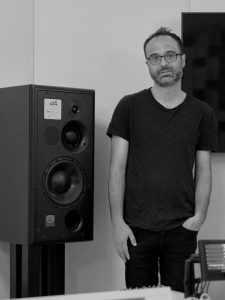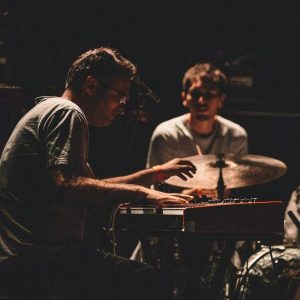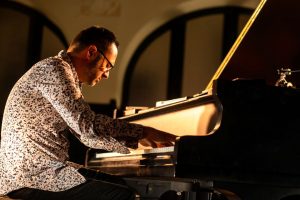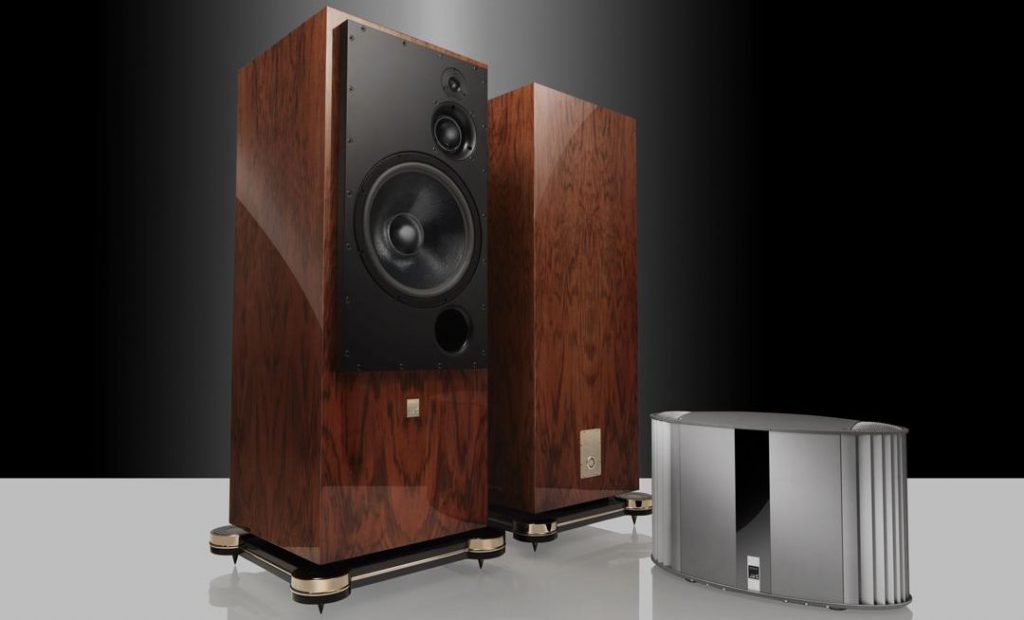Latest News
Artist Spotlight: Luke Howard
Australian Music Prize twice-long-listed composer Luke Howard has been described as “absolutely heavenly” (Mary Anne Hobbs, BBC Radio 6) and his music as “an ambient masterclass” (Musos’ Guide), but no words can fully capture the potency of Howard’s enthralling compositions. A pianist since childhood, Howard has scored films and performed with artists as diverse as Lior and Jeff Mills, capturing audiences with contemporary classical arrangements that curl and twist around the boundaries of a particular emotion. Though wordless, Howard’s songs perform a function unique to music as a medium – that of evoking without describing, bringing listeners to a feeling which defies articulating.
Back home in Melbourne, Howard recently composed music for the short film The Sand That Ate The Sea (nominated for best soundtrack in the 2019 ARIA Awards) and the theatre work The Shadow Whose Prey the Hunter Becomes (Back To Back Theatre). He has worked with choreographer, Juliano Nunes on pieces for the Royal Ballet in Covent Garden, and the Atlanta Ballet.
Howard is one of Australia’s foremost practitioners of contemporary classical music whose work continues to captivate audiences worldwide.
ATC caught up with Luke back in May, to find out a little more about how it all began, how he works in the studio and his experiences playing live….
ATC: Can you tell us a little about how your background and how your career in music began?
L.H: It’s probably not an uncommon story – I learned piano as a child at my parent’s suggestion – and I’ve just kept going. I suspect persistence is likely the real secret to a career in the arts. Of course, the story is a bit more nuanced: I studied jazz and improvisation at university as I enjoyed making things up, and didn’t have the technique nor repertoire to be a concert pianist. Much of my twenties and some of my thirties I oscillated between being a jobbing jazz pianist and a software developer, but in the past few years I’ve focused mostly on composition. I miss playing the piano as much as I used to, but I feel I can address bigger ideas, instrumentation, etc. as a composer. In a way, I’m just chasing the sentiment I first felt when I heard, say, Keith Jarrett. Trying to recreate that.
 ATC: ATC’s founder, Chairman and fellow Australian, Billy Woodman has a great passion for jazz and has played piano from an early age, even covering the cost of his journey from Australia to England by backing a singer onboard the boat that he travelled on. One of his great influences, and all-time favourite pianists is the late great, Bill Evans. Which musicians have had a strong influence on you and your music?
ATC: ATC’s founder, Chairman and fellow Australian, Billy Woodman has a great passion for jazz and has played piano from an early age, even covering the cost of his journey from Australia to England by backing a singer onboard the boat that he travelled on. One of his great influences, and all-time favourite pianists is the late great, Bill Evans. Which musicians have had a strong influence on you and your music?
L.H: Well, Bill Evans of course is an influence, but I think in my study of jazz piano I looked both before and after – I transcribed many Bud Powell solos, and then spent a good few years on a diet of Keith Jarrett and Brad Mehldau. They really define the language of modern jazz piano. The sadly departed pianists Lyle Mays and John Taylor were also huge influences, and aesthetically much more aligned with the music I make today. This of course is just a very narrow jazz piano lens – there’s much more music I love, including the artists I’ve mentioned so far, along with Philip Glass, Nico Muhly, Ryuichi Sakamoto, The Blue Nile, I could go on for days…
ATC: Piano is your primary instrument, but do you have any other instruments you are particularly fond of, both acoustic and electronic?
L.H: I am fond of many instruments, but I can’t play any of them save the piano (I’m pretty sure I’ve forgotten how to play the French Horn and oboe by now). I have a small cadre (which Google informs me is actually a tautology) of musicians I use on almost every record: effectively a jazz rhythm section, with guitar and violin, but used in more creative ways. So I love those textures. And, really, string orchestra is still my favourite ‘instrument’ for its emotional depth. I do look forward to the time when it will be possible to record with one again.
ATC: You incorporate electronic instruments and programming in your compositions. Is this an area of music you have been interested in for a long time or, a more recent development?
L.H: I’m a definite nerd but I’ve usually kept the two worlds fairly separate. I have been using synthesisers since I was a high school student thanks to some particularly forward-looking education programs in Australia (electronic music was offered as instrumental subject at my school). I’ve been reading audio magazines since approximately 1987 when my Dad bought me an issue of the now defunct Music Technology! As a jazz musician I didn’t listen to a whole heap of electronic music until recently, but I have been particularly inspired by how artists such as Nils Frahm, Jon Hopkins, Jóhann Jóhannsson, Max Richter, et al. have integrated acoustic and electronic elements.
ATC: Could you give us an overview of your studio setup?
L.H: I work mostly ‘in the box’, I have a few nice bits of outboard but beyond the things necessary to actually get the music into the computer in the first place, that doesn’t see a great deal of use. So what really matters are the room and the speakers. My room was designed by Adelaide acoustician Chris Morton. I have a very beautiful desk (of the non-mixing sort) designed by my friend, Thomas Jouanjean of Northward Acoustics. My speakers are a pair of ATC SCM50ASLs (fed by a Cranesong Solaris DAC), which to me are a perfect combination of musicality and truthfulness; not fatiguing to listen to for long periods, not flattering, but also not so clinical one doesn’t feel inspired. My piano is a Yamaha upright, nothing particularly extraordinary but one which records quite well. I’m a bit of a collector of reverbs and tape delays, too.
 ATC: When you are in the studio, do you have a pretty structured process you like to follow when recording and do you have a favorite place to record?
ATC: When you are in the studio, do you have a pretty structured process you like to follow when recording and do you have a favorite place to record?
L.H: I do a lot of recording at my own studio now, so I tend to record rough ideas on the piano, then work and edit them in the computer, and then re-record them if the original version wasn’t up to scratch. It depends on the piece: an orchestral piece might start as an improvisation on the piano or the computer, but most of the work will be done in notation, and it doesn’t really exist in a tangible form until it’s been performed. Other pieces I’ve improvised on the piano have ended up on the record with very little editing.
Regarding a favourite place to record: I loved recording at Rainbow Studio in Oslo when Jan Erik Kongshaug was alive…but it wouldn’t be the same without him. Again, it really depends on the composition, but I learned the lesson early that acoustic instruments need good rooms, and it’s a lot easier to bring recording equipment to a great sounding room, than a good acoustic to a poor studio. High land prices have forced the closure of many studios here and elsewhere, so nowadays we are usually recording ensembles in a concert venue, and solo instruments in smaller spaces. One of my favourite released albums, Ten Sails, was recorded in a Berlin apartment. Good music recorded in a less than ideal room will always trump the converse, but great music in a great room is ideal!
ATC: Are there any technologies that have had a particularly strong influence on your ‘sound’?
L.H: Most of the music I make has an acoustic genesis, using instruments which haven’t changed for hundreds of years. I am fond of treating sounds using delays, reverbs, etc. but I’m fairly certain I’m using exactly the same tools as everyone else, and I arrived at a ‘sound’ simply through experimenting with them. I love a beautifully recorded Steinway just as much as an upright piano with some felt draped between the hammers and strings (I’ve actually been using a distinctly Australian cleaning cloth – Chux – as a replacement for felt of late!). I did buy a Prophet 6 synth a couple of years ago, which I’m slowly getting to know, so you might hear more of that on the next album.
 ATC: I read that you performed live as part of the Melbourne Symphony Orchestra alongside iconic techno artists Jeff Mills and Derrick May. On paper, an unlikely musical combination! but can tell us a little about how that came about and the experience?
ATC: I read that you performed live as part of the Melbourne Symphony Orchestra alongside iconic techno artists Jeff Mills and Derrick May. On paper, an unlikely musical combination! but can tell us a little about how that came about and the experience?
L.H: Well, my name must be somewhere on a list of casual musicians as the Melbourne Symphony calls me occasionally when they need someone who can both read music and improvise. It was an interesting gig, certainly a lot of fun but the nature of amplifying an orchestra means that I couldn’t hear what Jeff and Derrick were doing too clearly. I do have a good story from that gig though, which might also explain why I haven’t heard from them since: I had a long solo feature just before the final song Strings of Life, and as I took a bow for this, my earpiece (with the click track) fell out. By the time I got it back in, I didn’t know where in the bar I was, let alone which bar! It was a pretty excruciating moment in front of many thousands of people – suffice to say when the gig ended I snuck away very quietly. To this day I’m not sure if anyone in the audience noticed, but the conductor certainly did!
ATC: Many people have had more time on their hands the past few months and are listing to more music and/or are looking for new artists and sounds to explore. Can you recommend three artists or albums that you have been enjoying recently?
L.H: I often go back to Talk Talk’s Spirit of Eden. It’s a perfect record. Keaton Henson’s Six Lethargies is a beauty. Other favourite artists to check out that your readers may not have heard of are Bing & Ruth, Ben Lukas Boysen, Marty Hicks and Hania Rani.
Quick plug! – a new live record of solo piano music, All That Is Not Solid, releases 30th July on Mercury KX (Decca/Universal). It was recorded in January this year, at the height of the Victoria bushfires. Listen to the track Passions of All Kinds here. I also recently released a book of sheet music which is available here.
Luke Howard: Website – Instagram – Facebook – Spotify – Tidal – Qobuz
PRODUCT LAUNCH: SCM150ASLT LE
New Limited Edition SCM150ASLT LE Active Loudspeaker System
Limited edition system brings exceptional focus to a 45-year heritage of innovation and precision engineering…
ATC loudspeaker Technology is proud to announce the availability of the SCM150ASLT, a luxurious marriage of world-class transducer and electronic design engineering, conceived to deliver extraordinary levels of clarity, neutrality, transient response and effortless power delivery.
The 3-way system comprises flawlessly engineered SCM150ASLT speaker towers incorporating the latest ATC designed and built drive unit technology, combined with an ATC P6 power amplifier. SCM150ASLT drivers including the new 25mm neodymium soft dome SH25-76S super dome tweeter, the 75mm soft dome SM75-150S super dome midrange and the SB75-375SL super linear bass driver are driven directly by the six dedicated channels of the P6 dual-mono, 3-way power amplifier, housed in an elliptical billet aluminium chassis, exquisitely machined and finished to complement the impeccable quality of the cabinets.
Manufactured to the highest standard by ATC’s own cabinet makers, weighing 116kg and at approximately 1.4m tall, each speaker enclosure is finished in selected European crown-cut walnut veneer with a high-gloss polyester lacquer, and detailed with a stainless steel badge, input panel and bespoke limited edition plinth, PVD treated to create an exclusive nickel-like appearance.
SCM150ASLT Speaker
Deploying proprietary drivers throughout, the 3-way system uses ATC’s new SH25-76S tweeter, featuring both upper and lower suspension for greater operational precision and lower distortion; the latest evolution of ATC’s signature soft dome midrange design, the SM75-150S, and the company’s low-distortion SB75-375SL Super Linear bass driver. Combined they deliver a response accuracy of ±2dB between 60Hz-17kHz and ±6dB from 25Hz to 22kHz across a wide horizontal dispersion and at a maximum SPL of 117dB. The rear-mounted input panel features a single LEMO aerospace-grade 10-pin connector.
P6 Power Amplifier
The P6 is a high-performance Class AB dual-mono power amplifier designed and built by ATC to provide dedicated amplification and optimally matched active crossovers for the SCM150ASLT. It features a total of 6 channels: 2x (200W LF, 100W MF, 50W HF) for a combined output power of 350W/side. Generating a signal-to-noise ratio of more than 105 decibels its ultra-low noise discrete design, paired with 3-way active crossovers with phase equalisation, offers clear and detailed audio reproduction. On the rear panel, professional L/R XLR inputs (from preamplifier/digital source) are joined by aerospace-grade LEMO multi-pin loudspeaker output connectors. Proprietary speaker cables are included with the system.
As is customary with ATC products the SCM150ASLT and P6 are covered by a six-year warranty.
Available to order immediately. Product built to order, earliest shipping Wednesday August 5th.
Recommended UK retail price is £46,600 inc VAT. If you are located outside the UK, please contact the dealer or distributor in your region for pricing. A list of ATC authorised dealers and distributors can be found here.
Further product details can be found on the SCM150ASLT LE webpage.







